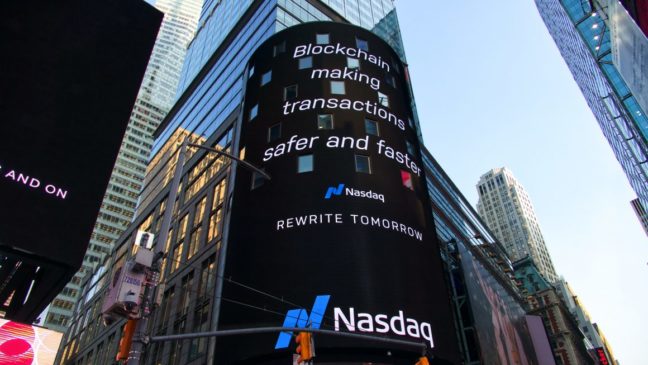Among the many disruptions to daily life we’ve experienced over the past few months, cancelled events comprise a large number. One such event that we at Forkast.News had been looking forward to bringing you to was the DC Blockchain Summit, in what was supposed to be its fifth year of convening industry leaders, regulators, and innovators in this space. (In light of the pandemic, it has been transformed into the Parallel virtual event series, set to run over the course of the next five months with modified panels and speakers.) In the meantime, despite many of us still being sequestered in our homes, technology and knowledge-sharing keep moving on.
One of the scheduled speakers at the DC conference that Forkast.News will bring to you now is Mike Cagney, co-founder and CEO of Figure Technologies Inc., a fintech company that uses blockchain to simplify and reduce the time required for home equity loans. Figure made headlines last year for making unicorn status within two years of its conception, and the company is currently valued at US$1.3 billion.
Before starting Figure, Cagney was already a serial entrepreneur with a deep background in consumer loans. When he was a Sloan Fellow at Stanford University’s Graduate School of Business, Cagney co-founded Social Finance (SoFi), a loan-refinancing company and one of the few startups to achieve a billion-dollar funding round. SoFi is currently worth over US$4 billion. Cagney also co-founded Cabezon Investment Group, a hedge fund, and Finaplex, a wealth management technology company. Prior to that, he was a senior vice president at Wells Fargo, where he started his career as an analyst and coder.
The following Forkast.News interview with Cagney has been edited and condensed.
How has blockchain changed the financial services industry so far? How does it have the potential to, and what are the conditions needed for it to do so?
I think the securitization we completed in early March — showing the power of blockchain from loan origination, through to financing, and ultimately to takeout — demonstrated the potential of blockchain technology. We identified over 130 bps (basis points) of savings, with the potential for more, leveraging the distributed, trustless and immutable nature of blockchain. Look for more production examples — not proof of concepts — in fund custody and administration, banking and payments, and broader lending categories like first mortgage.
There are compelling arguments for both sides of the debate on whether or not regulatory authorities should be more heavy-handed and issue more comprehensive guidelines with oversight of distributed ledger technologies. How do you think regulatory agencies should act moving forward? How do you think they will act?
I think it’s important that blockchain operates within the rules. It shouldn’t be a regulatory arbitrage. However, the technology makes certain rules irrelevant. For example, do you need a qualified custodian if you have a digital asset on a distributed ledger? Probably not. So I think it’s important for the SEC, the Federal Reserve, and others to be involved, but they have to look at this as a new operating paradigm.
In what ways, if at all, do you think blockchain could play a role in this current coronavirus crisis? For example, processing medical insurance claims, tracking medical supplies, or even vaccine research?
The concern around the virus has had a cascading impact on the capital markets. Traditionally deep markets — like jumbo mortgage — have shut down because of concern around collateral performance. The over-the-counter nature of these markets has exacerbated problems with transparency, and thus liquidity. Blockchain could provide certainty with regard to collateral performance, in a bilateral marketplace where everyone has the same information. That would keep markets working and reduce the need for some of the Federal Reserve and Treasury open market activities and guarantees.
In some respects, the current global recession rivals or exceeds the magnitude of the 2009 financial crisis. How do you expect this to impact the blockchain space, and what steps can we take to ameliorate its effects?
There was a time when any startup with “blockchain” in its business plan had a good shot at equity capital (directly, or through an ICO). Those days are gone, and I expect you’ll see considerable consolidation into the businesses with the highest immediate commercial opportunities. This is both good and bad; it means we’ll see more production use cases of blockchain, but it also means some of the moonshot projects will take longer to come to market.
With unemployment spiking due to the pandemic, do you expect the kind of clients’ loans at Figure or their demographics to change?
We’ve seen an increase in forbearance, but we had lower forbearance than Fannie Mae mortgages and the forbearance rate has been steadily declining the last few weeks. What we have seen is investor demand for Figure assets, because we have real-time performance versus 30+ days for other mortgage assets.
Is it conceivable that banks might become obsolete with the advance of technology — blockchain, AI, etc. — and growing applications?
Banks won’t become obsolete, but the role they play might change. Blockchain has the ability to eliminate the infrastructure banks use to move money — interchange, wire, etc. — and this introduces a greenfield opportunity to rethink banking solutions.
You recently noted that inefficiencies in economic stimulus payments have exposed the need for the adoption of a digital dollar. How have the Congressional bills so far fallen short in setting one out, and what are the domestic reasons for adoption?
The stimulus shortcomings are a great example of the need for digital dollars, but the needs go well beyond today. Think about social security or food stamps — basically any government program can benefit from blockchain as a distribution agent, particularly into un- or underbanked consumers. I think there is a will in government to do this, but they haven’t seen a clear way — yet.
With China ramping up its central bank digital currency agenda and the U.S. still struggling to recover from Covid-19, is American economic hegemony under threat? Why, if at all, should the U.S. compete in the race to currency digitization?
China is already ahead of the U.S. on payments — look at Alipay vs. the interchange. The U.S. will have to adopt more frictionless ways to move money and assets to stay competitive.
In light of recent events, do you think that blockchain application, whether through facilitating access to loans or underpinning state-sponsored cryptocurrencies, has a net positive or negative effect for social equality, and why?
By removing friction in banking and payments, there is a path to deliver robust financial solutions to everyone, regardless of their income, credit history, etc. But we haven’t realized that yet. So I’d say there is opportunity for tremendous social impact.
Is widespread adoption inevitable, and what kind of a time frame can we expect?
Yes, and it will happen much sooner than people think. An example is the rapid adoption we’ve gotten from financial institutions to use Provenance blockchain for loan custody and administration, after purchasing the loan from Figure. Every bank and fund that has bought loans from us in the past year has kept them on Provenance, and many are looking to move other assets onto the blockchain because of the economics and efficiencies. Adoption won’t be a slow conversion, but a rapid transition away from the archaic infrastructure and onto blockchain, and it will happen this decade.
Mike Cagney, Co-Founder and Chief Executive Officer
Mike Cagney is the co-founder and chief executive officer of Figure, where he leads corporate strategy and development. Mike previously served as CEO, chairman and co-founder of SoFi, a leading marketplace lender providing student loan refinancing, mortgages and personal loans, as well as wealth management services.
He is also co-founder and managing member of Cabezon Investment Group, a global macro hedge fund, in addition to serving as a non-executive chairman of ReFlow. Before Cabezon, Mike founded, was CEO and chief architect of Finaplex, a wealth management software company. Mike holds an M.S. degree from the Stanford Graduate School of Business, where he was a Sloan Fellow. He also holds degrees in economics from UC Santa Cruz.




